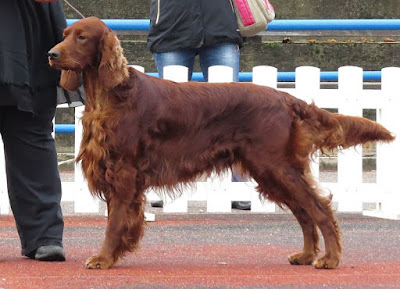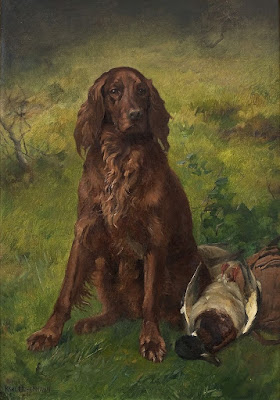Irish setter is a family dog of the gundog breed. The term Irish setter is generally used to encompass the show-bred dog introduced by the AKC (American Kennel Club) and the field-bred Red Setter presented by the Field Dog Stud Book.
Size and Weight
The normal height of Irish setter ranges between 24 to 28 inches (61 to 71 cm). The average weight of males between 29 to 34 Kg (65 to 75 lb) and females between 25 to 29 Kg (55 to 65 lb).
As per FCI Breed Standard, the males stand between 23 to 26.5 inches (58 to 67 cm) tall, whereas, females between 21.5 to 24.5 inches (55 to 62 cm) tall.
Lifespan
The life expectancy of Irish setter is 11 to 12 years.
Coat and Color
The coat of Irish setter is abstemiously long and silky; of red or chestnut color. It needs regular brushing to maintain its condition and keep it mat-free. The undercoat is abundant in winter seasons, and the upper coat is good. Their coats should also feather in places such as the tail, ears, chest, legs, and body. Irish Setters are deep chested dogs with small waists.
Temperament
The Irish setters are sociable with children, other dogs, and will strongly greet visitors. Although they do well with domestic pets, small animals may create a problem for this breed, as they are a hunting breed. Some Irish Setters may have difficulties with cats at home and maybe too rowdy with small children. Yet, the breed is very affectionate and proved to be excellent companion dogs and family pets.
Irish setter is an active breed which requires long and daily walks in wide open areas. Irish setter is, however, a breed with a tendency to 'play deaf,' so careful training must be given for mastering at recall before allowing them off-lead.
Irish Setters enjoy having a job to do. Lack of activity will lead to a bored, unhelpful, or even agitated dog. This is not a breed that can be left unaccompanied in the backyard for a long time. Irish Setters are much excited with a constant human company. Irish Setters are highly intelligent and respond quickly to a positive training.
Although they are usually alert to their surroundings, the dogs are not suitable as guard dogs, as they are not a naturally self-confident breed. Irish Setters are also commonly used as therapy dogs in schools and hospitals. They are allowed in hospitals with special permission and can visit patients on the assigned floors. This is a venue where the therapy dogs are allowed in schools and then asked to sit with children as the students read to the Irish setter. This process supports to enable the students the ability to read without being corrected or judged. Usually, the Irish setter will lie on the floor with students as they continue to read, in this calming and relaxed setting.
Uses in Hunting and Shows
Irish setter was originally bred for hunting, especially for locating and pointing upland game birds. They are diligent, wide-range hunters, and compatible to fields and wet or dry upland terrain. Using their excellent sense of smell to find the mark (or bird), the Irish Setter will then hold a pointing position, indicating the direction in which the bird lies hidden.
Frank Forester, a 19th-century sportswriter, described the Irish Setter as: "The points of the Irish Setter are more bony, angular, and wiry frame, a longer head, a less silky and straighter coat that those of the English. His color ought to be a deep orange-red and white, a common mark is a stripe of white between the eyes and a white ring around the neck, white stockings, and a white tag to the tail."
Setter that was totally red, however, the dog was selected in the show ring that is the direction that the breed took. The breed produced 760 conformation show champions and 5 field champions between 1874 –1948.
Working Red Setter
The modern Red Setter is usually smaller than its bench-bred partner. The average weight of Working Red Setter is 20 Kg (45 lb), whereas, show dogs have a weight of 32 Kg (70 lb). The coat of working Red Setter is usually less silky with lighter colors of russet and fawn. The feathering is usually shorter. The dog has white patches on its face and chest like an old Irish setter. There have been efforts to regenerate the field abilities of true type Irish by a minority of dedicated breeders in California with some success.
History
It is clear that, by the early 18th Century, the 'Setter' had come into its own right. It is also clear that Irish setter had started actively breeding their own type. For example, the de Frayne family of French Park started keeping detailed stud records in 1793. Other prominent landed Irish gentry also knew to have been breeding setter lines at the same time include Lord Clancarty, Lord Dillon, and the Marquis of Waterford.
It was noted as early as 1845 that setters in Ireland were mostly either red or very red, red and white, lemon colored, or white patched with deep chestnut. Obviously, the preference for a solid red-colored dog was having an effect on the appearance of the typical Irish-bred setter.
The breed standard for the modern Irish setter was first drawn up by the Irish Red Setter Club in Dublin and approved on 29 March 1886. It comprised of a 100-point scale, with a given number of points awarded for each of the dog's physical attributes. The points system was later dropped; however, apart from some slight changes, the standard remains largely unchanged today in most countries where the breed is formally recognized.





